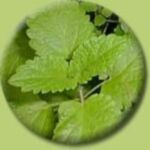
A member of the mint family, lemon balm has been used since the Middle Ages to lift the spirits, reduce stress and anxiety, promote sleep, ease flatulence, and improve appetite. Lemon balm also has antiviral properties and has been found to be very effective in treating herpes simplex cold sores.
Lemon-scented perennial with a 4-angled stem and ovate, toothed leaves, 3-7cm (1¼-3in) long. Insignificant, pale yellow flowers are produced in axillary clusters in summer.
|
|||||||||||||||||||||||||||||||||||||||||||||||||||||||||||||
The ancient Greeks gave lemon balm its official name—melissa is Greek for “bee”—and both the Roman and Greeks used the herb to treat dog bites, insect bites and infected wounds. They also discovered its calming and pain-relieving effects when they mixed the herb with wine. In the ancient Middle East, Arab physicians used lemon balm to treat depression and heart ailments. By the 1500s, many European herbalists viewed lemon balm as a panacea for all life’s ills. The fifteenth-century Swiss alchemist and physician Paracelsus called lemon balm the “elixir of life”, and by the late seventeeth century, Britain’s official London Dispensary of medicinal herbs listed lemon balm as a surefire longevity herb (and a cure for baldness!). This inspired many apocryphal tales of lemon balm’s miraculous powers, including that of John Hussey, who lived in Sydenham, England, and lived to the ripe old age of 116 by drinking lemon balm tea every morning for 50 years. Despite such glowing accounts, lemon balm began to fall out of favor by the nineteenth century. In the twentieth century, however, German scientists repopularized lemon balm by identifying its astounding array of therapeutic properties—many of which seem tailor-made for the extraordinary stresses and demands of twenty-first century life. |
|||||||||||||||||||||||||||||||||||||||||||||||||||||||||||||
An aromatic, cooling, sedative herb that lowers fever, improves digestion, relaxes spasms and peripheral blood vessels, and inhibits thyroid activity. It has anti-viral, anti-bacterial, and insect-repellent effects. |
|||||||||||||||||||||||||||||||||||||||||||||||||||||||||||||
|
|||||||||||||||||||||||||||||||||||||||||||||||||||||||||||||
To treat depression, vomiting, headaches, Alzheimer’s disease, elevated blood pressure, menstrual irregularities, muscle stiffness, nerve pain, and rheumatism. Lemon balm has antibacterial, antidepressant, antiflatulence, antispasmodic, antiviral, calming, sedating, and sleep-promoting properties. It also aids digestion, soothes the stomach and intestinal tract, and promotes perspiration. It is taken internally for anxiety, depression, fevers, heart palpitations, hyperactivity (in children), hyperthyroidism, insomnia, indigestion, irritable bowel syndrome (IBS), menstrual cramps, muscle spasms, and tension headaches. It is applied externally to treat herpes, insect bites, and minor rashes, sores, and wounds. The essential oil of lemon balm is famously used in aromatherapy to relieve stress and promote sleep. |
|||||||||||||||||||||||||||||||||||||||||||||||||||||||||||||
|
|
|||||||||||||||||||||||||||||||||||||||||||||||||||||||||||||
| DIGESTIVE | CIRCULATORY | RESPIRATORY |
| Melissa 5 | Melissa 4 | Melissa 4 |
| Peppermint 3 | Ylang-Ylang 4 | Ginger3 |
| Cardamon 3 | Clary Sage 2 | Eucalyptus 3 |
|
|
||
| REPRODUCTIVE | NERVOUS | EMOTION |
| Melissa 5 | Melissa 4 | Melissa 4 |
| Geranium 4 | Vetivert 3 | Orange 4 |
| Basil 2 | Chamomile (R) 2 | Frankincense 3 |
The Encyclopedia of Herbs by Deni Bown Copyright © 1995, 2001 Dorling Kindersley Limited pp. 274-275.
The Essential Herb-Drug-Vitamin Interaction Guide by Geo. T. Grossberg,MD and Barry Fox,PhD Copyright©2007 Barry Fox,PhD. Pp.304-306.
The Modern Herbal Primer by Nancy Burke Copyright©2000 Yankee Publishing, Inc. pp. 74-75


